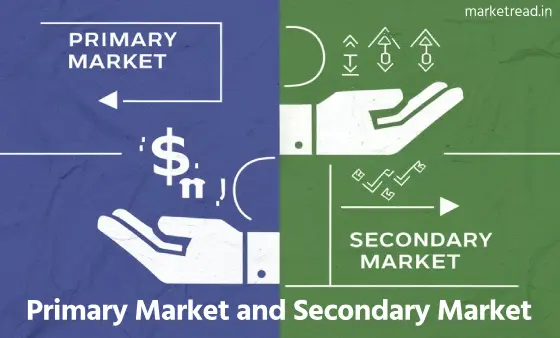Primary and Secondary Market: Meaning and Difference
As you are learning about the stock market, you might have heard of these two terms, The Primary Market and the Secondary Market. But don’t get confused between these two, these are just different stages of the life cycle of a stock. Now, Let’s understand what it means, “Primary Market and Secondary Market” and how they work.
What is the Primary Market?
The primary market is also called as Fresh market, the New issue market or sometimes the First Market. Only names are different but functioning the same. The primary market is a function or a place where new securities are created for investment purposes and offered to the general public for the first time.
In this market, companies issue an IPO to investors to meet their requirements for funds. In a simple word, The primary market means an opportunity for companies to raise funds to fulfil their various purposes, such as expanding business operations, paying off debts or other general financial actions etc.
Let’s understand quickly how it works, When a company decides to go public or issue new securities, it hires an investment bank or underwriter to research about company’s financial performance, market conditions, and investor demand. The investment bank or underwriter helps the company determine the actual price at which the securities can be offered to the public.
After fixing or determining the price of a security, an IPO is introduced to the general public (investors). in the primary market interested Investors buy shares or bonds directly from the issuing company. This means the funds invested directly go to the company, allowing them to raise capital.
The primary market is open for a limited period, which means investors have to invest within the given period. After the end of that period, IPOs get listed in an open market. To know in detail about IPO and its function you must read this post. What Is an IPO?
What is the Secondary Market?
As we know the Primary market is the First market, here we can call the secondary market as second market or aftermarket. In simple words, aftermarket means a market which functions after the primary market.
As we previously discussed first issued securities are bought by investors in the primary market, and after the primary market those securities, get listed on an exchange. This means not they can be traded in the secondary market or open market. A secondary market is a place or a platform where investors buy and sell stock of a company without the involvement of the issuing company.
And now as investors trade securities among themselves in the secondary market, the prices are determined by the supply and demand. Hence, the price of a stock, or security can fluctuate time by time based on various factors, such as the company’s financial performance, market conditions, investor sentiment, and economic indicators.
In The secondary market, Investors can choose to hold securities for a long period as part of their investment portfolio or use them in short-term trading to take advantage of price fluctuations.
The Relationship Between the Primary Market and Secondary Market
The primary market and secondary market both are interconnected and play complementary roles in the stock market ecosystem. The overall thing is that The primary market provides an opportunity for companies to raise capital by issuing new securities, while the secondary market provides liquidity to investors who want to buy or sell existing securities.
When a company issues new securities in the primary market, it increases the supply of securities available in the secondary market. Thus, this affects the price and trading volume of the securities in the secondary market. If there is a high demand for newly issued securities, it can lead to an increase in the price. On the other hand, if there is low demand, it can lead to a decrease in the price.
Investors in the secondary market can also influence the primary market. If there is high demand for a company’s securities in the secondary market, it can indicate investor confidence in the company’s prospects. This can encourage other companies to consider issuing securities in the primary market to raise capital.
Conclusion
The primary market and secondary market are integral parts of the stock market. The primary market allows companies to raise capital by issuing new securities, while the secondary market provides liquidity to investors who want to buy or sell existing securities. Understanding the functions and relationship between these markets can help investors make informed decisions and navigate the world of stock market investing.
FAQs
What is the difference between primary and secondary market?
The primary market is where the financial instruments (Stocks, Bonds) are introduced first time to the public, and the Secondary market is where these securities are traded between the investors.
Example of Primary and Secondary Market?
All fresh securities introduced to the public for investment as an IPO, we can call it a Primary Market, and when this IPO gets listed for trading, the listing place we can call a Secondary Market.
Relation between Primary and Secondary Market?
The primary market provides an opportunity for new companies to raise capital by issuing new securities, while the secondary market provides liquidity to investors who want to buy or sell existing securities.

I like this site very much, Its a very nice billet to read and obtain information.